Turkish Ottoman Navy
 The Ottoman Empire’s Navy:
The Ottoman Empire’s Navy:
The story of the Ottoman navy goes back centuries, after the fall of Constantinople in 1453. By then an empire was born, that would take the lead in the Mediterranean. Its fleet mostly counted galleys and fast ships based on galley hulls (Xebec and derivatives). In 1571 when the fleet was at its peak, its golden age, a pivotal battle took place between it and a coalition of Christian powers. This defeat however never really stopped the effort of Sultans to dominate the area until the XIXth century.
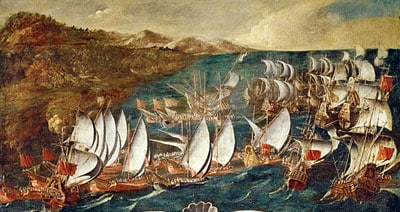
Certainly the poor relative of the Turkish army, the navy had been once the most powerful of the Eastern Mediterranean for several centuries. In 1870, it still dominated the Russians in the Black Sea, and was unavoidable in the Indian Ocean and the Red Sea, not to mention the Mediterranean. But since the empire had suffered defeats, which had been destroyed by considerable losses of territory, the navy had seen its budget dwindle at great speed.
Published & to come
Cruiser Hamidieh (1903)
Cruiser Midilli (1914)
Namet Torpedo cruisers (1890)
Sahahani Deria Torpedo cruisers (1892)
Destroyers class Berk-Efshan (1894)
Destroyers class Yarishar (1907)
Destroyers class Muavenet (1909)
Berk i Savket class Torpedo gunboats (1906)
Marmaris gunboat (1903)
Sedd ul Bahr class gunboats (1907)
Isa Reis class gunboats (1911)
Preveze class gunboats (1912)
Turkish WW1 Torpedo Boats
Turkish Armed Yachts (1861-1903)
Turkish WW1 Minelayers
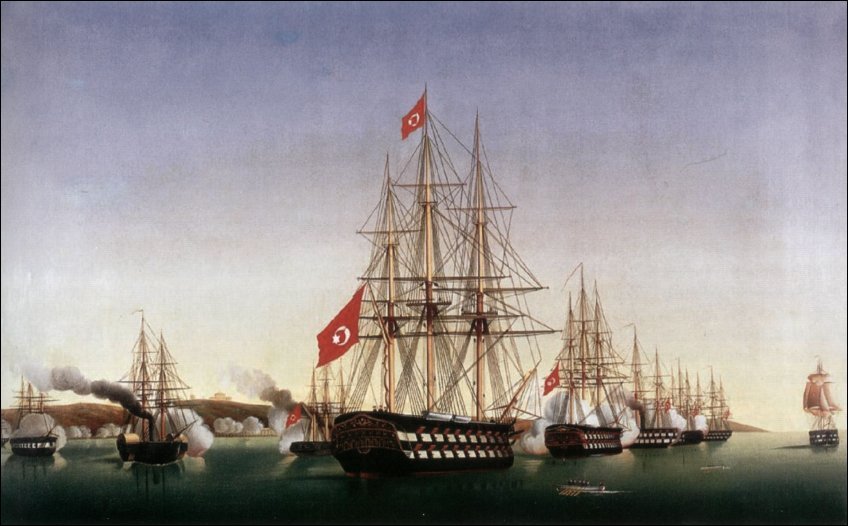
There were virtually no new orders from abroad. The defeats suffered in the face of the Russian fleet were not foreign to it, and the navy had lost its prestige and the confidence of the rulers of the empire. If it had played a major role in the ousting of Sultan Abdul Aziz for the benefit of Abdul Hamid II in 1878, it was dismantled and demoralized; Without maintenance, its numerous and powerful units were abandoned and rotted with rust.
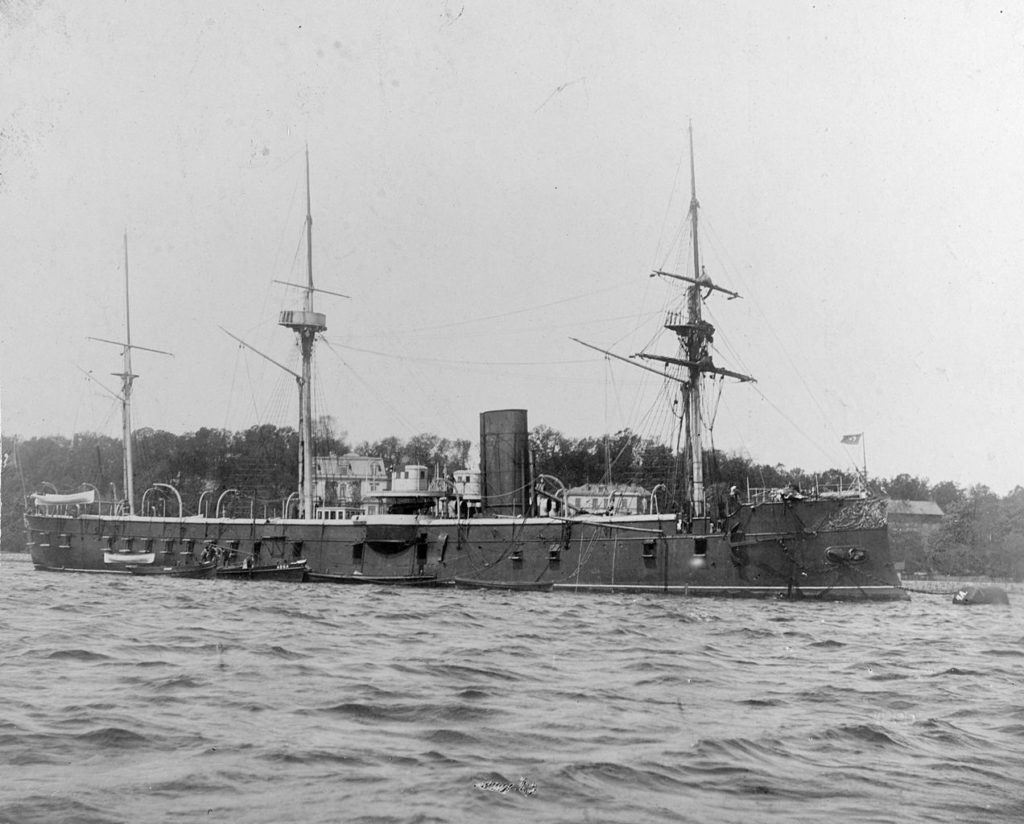
Armoured Frigate Asar-i Tevfik at Kiel, 1905
Beginning in 1884, a few orders gave way, but did not alter the pace of decommissioning of powerful buildings. In 1890, an ambitious new plan had been issued for orders of Hoche battleships to France and the reconstruction of old battleships, but no orders for cruisers or destroyers were pursued. At the beginning of the century, two new cruisers and destroyers were built and acquired but were also condemned to total inaction while the old battleships were modernized and converted into coastal ships.
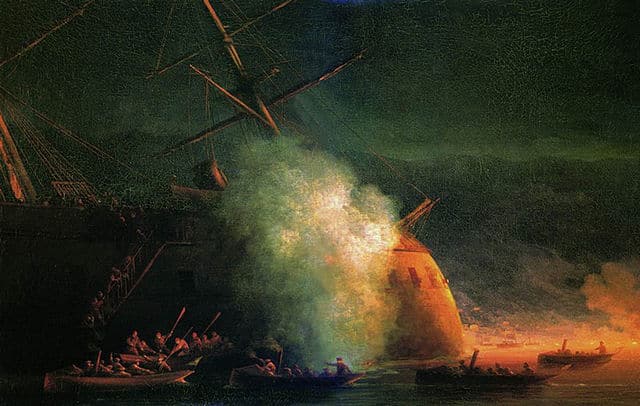
Assari Shevket assaulted and burnt by Russians steamer boats of Grand Duke Constantine on the Sukhumi roadstead, August 12, 1877
The coup d’etat of the “young Turks” was going in 1909 to change the attitude of Turkey vis-à-vis its fleet. This nationalist movement reacted to ambitions of naval power, and announced at the outset a 6-year naval plan consisting of 6 battleships, 12 destroyers, 12 torpedo boats and 6 submersibles. The realization of this plan was delayed so that when the war broke out in 1911 with Italy, the Turkish fleet was completely unprepared. In order to deal with the emergency, the government bought 2 German battleships and 4 destroyers, as well as rapid civilian ships for reconversion into gunboats.
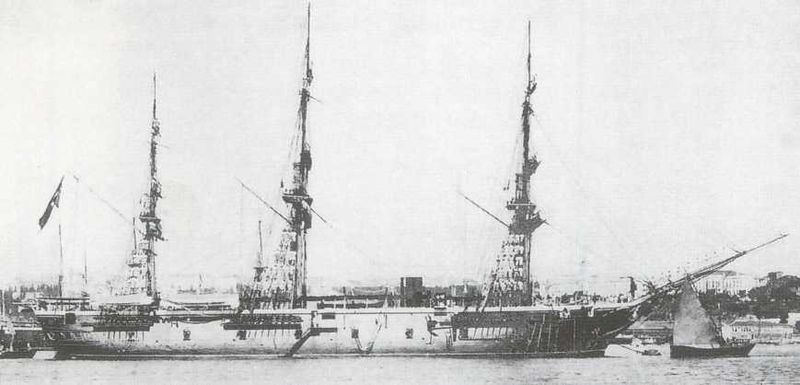
Ottoman Frigate Ertrugul
This decision was to be credited to the two British Rear Admirals, William and Gamble, who had been appointed to the fleet in 1910 by their naval commission in Istanbul. Nevertheless, the lack of audacity of the fleet meant that few sorties The fleet consisted of the two battleships, two cruisers, and five destroyers, came out of the Dardanelles to anchor in Beirut, but the vessels in other ports on the coast, including Izmir, were cut to pieces by the Italian Navy. His forces could not prevent the Greeks from taking control of almost all the islands of the Aegean Sea during the Balkan war.
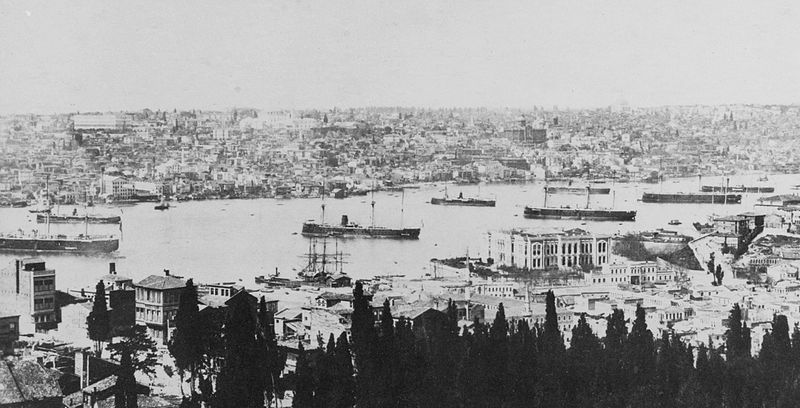
Ottoman Fleet in the golden door
At the beginning of this war against the Greeks, one of the aims of which was to retake Crete, Turkey bought back to Britain the battleship Rio de Janeiro, which should have been called Sultan Osman I. We know that the latter Was at its completion integrated into the Royal Navy. Other orders were given to Germany and France, but none were definitive. It was also studied the possibility that large British shipyards would take over a number of Turkish ports, including Izmir, by a thirty-year lease, but the outbreak of war ended the project.
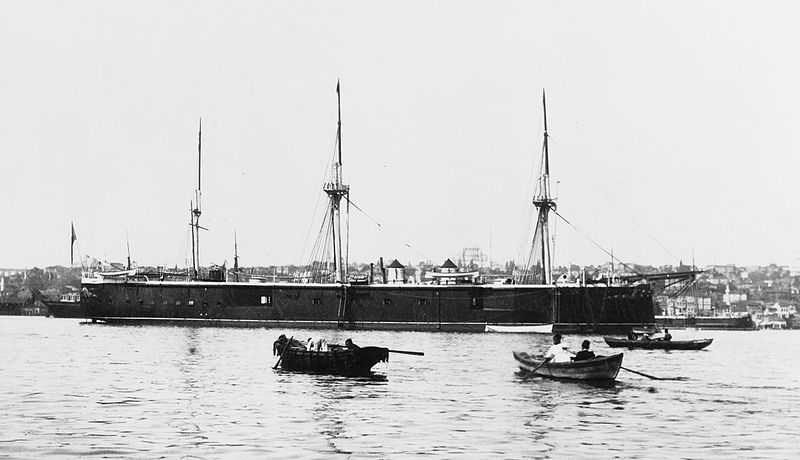
Ottoman ironclad Mesudiye, at the origin (1870s)
In 1914, the Turkish army was very effectively guarded by German officers (a military mission had been installed since the end of 1913 under the orders of General Von Sanders). The navy, partly equipped with the German, was also influenced by the policy of Berlin. When in August the Turkish ships ordered were seized by the British, public opinion but especially the nationalist government declared war on the triple agreement.
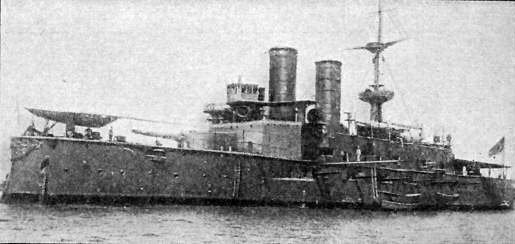
Ottoman ironclad Mesudiye in 1914
A miracle then took place: In the Mediterranean was the German squadron composed of the battle cruiser Goeben assisted by the cruiser Breslau. This squadron, commanded by Rear Admiral Wilhelm Souchon, was at Alexandria, which he was to leave in disaster, and the French and British naval forces were preparing to hunt down and annihilate it. Against all expectations in his desperate position, Souchon chose to rally directly to the Dardanelles and to take refuge in Constantinople, which he reached on the 11th of August.

The Abdul Kadir was a Britih-plans pre-dradnought battleship built in Constantinople that was never completed (1909)
At that moment the two ships were refugees in a neutral port, and the Turkish government, with the consent of Berlin, bought the two ships, which at once strengthened the fleet two fold. As of November 1, the Ottoman Navy reorganized around the Yavuz, shelled large Russian ports of the Black Sea.
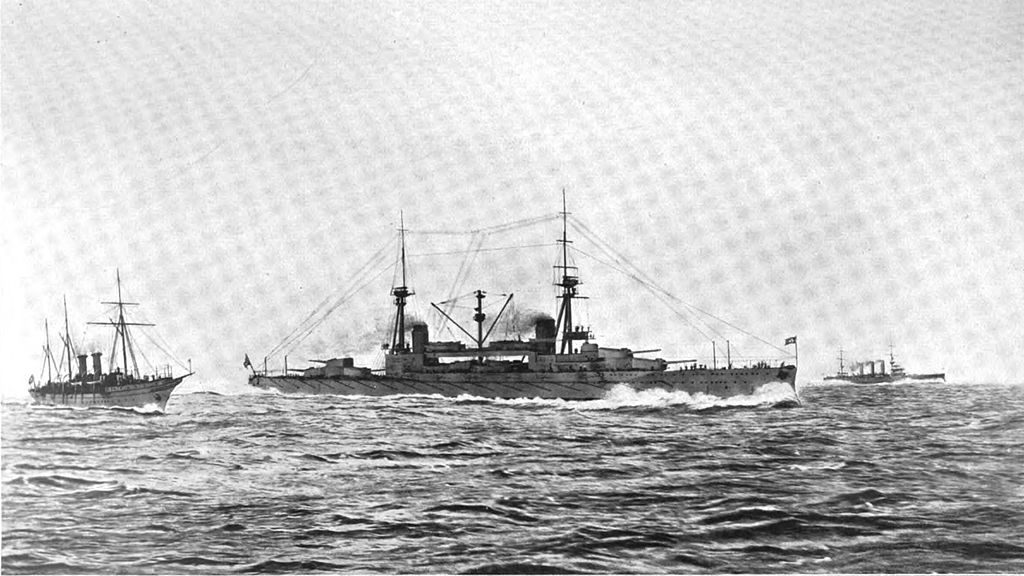
Sultan Osman I artist impression, Brassey’s Naval Annual 1914. The ship was to be resold to Brazil but ended in British service as HMS Agincourt.
However, this reinvigorated fleet never made a sortie westwards while the Dardanelles’ forts, mines, nets and batteries would inflict more damage on Franco-British forces during their attempted landings than any other Mediterranean force of the Central Empires. Raids of Turkish-German ships were infrequent but effective, and contributed to the disorganization of Russian supply convoys. In addition, flotillas in Mesopotamia, on the Euphrates and the Tigris, were set up to fight against the British, using small German ships that came through Bulgaria.

Resadiye was seized by the British Government in 1914 and completed, put into service as HMS Erin.
In 1918, however, the Turkish military situation had settled on land to the south, whereas Mudros fell at the right time. The fate of the Goeben would normally have been to join other ships of the Hochseeflotte sent captive to Scapa Flow, but under the new name of Yavuz Sultan Selim and command of Admiral Arir Pasha, she seemed to escape this fate as now permanently integrated into the Turkish fleet, although interned in Izmir under British control. By the treaty of Sèvres in 1920, however, this Ottoman fleet was singularly amputated by discarding and breaking up several ships, reduced to 7 gunboats and 6 torpedo boats whose armament was precisely limited. The Yavuz, like the rest of the heavy ships, was supposed to be given to Great Britain or Japan.
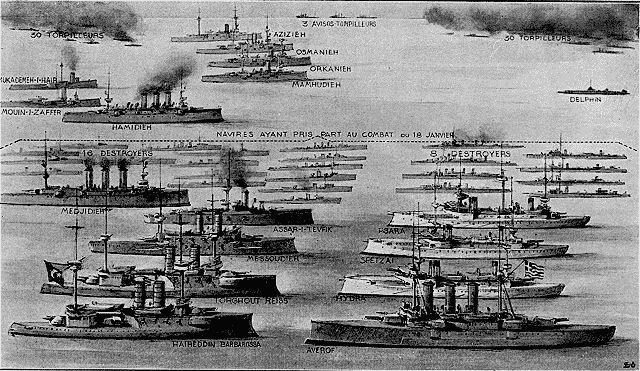
Ottoman and Greek fleets in 1913
Finally, in 1922, Mustafa Kemal (Ataturk) in Anatolia kicked the Sultan Mohammed VI in 1922 after a revolution and a civil war, and the two gunboats of the Kemal forces took refuge in the Fleet of the Black Sea, then in the hands of the “Reds” to avoid capture. Finally, the Turkish Forces defeated the Greeks and their victory was recognized by the Treaty of Lausanne on July 24, 1923. This agreement also signed the release of the Turkish fleet interned in Izmir and saved the battleship Yavuz for good.
The ship would be modernized and refitted, which was carried out by the Gölcük Naval Shipyard from December 1927, overseen by French Atelier et Chantiers de St. Nazaire-Penhöet. Sh was renamed again just “Yavuz” in 1936 and was slightly refitted in 1938. Turkey was neutral during WW2 despite pressure, and the ship was still in service at the beginning of the cold war. Sadly, whereas she was decommissioned in 1953, she was not scrapped until 1973, and all this time nobody tried to have her purchased for preservation, as the only example of a WW1 battlecruiser afloat. Turkey did not had the budget, but contacted the Federal Republic of Germany and offered to sell it in 1963 as a museum ship. But the Western Germans had other priorities than restoring and showcasing an Imperial ship, associated with an old militaristic regime and the rest of the world did not created a collective. Nowadays only her propeller is showcased at Gölcük.
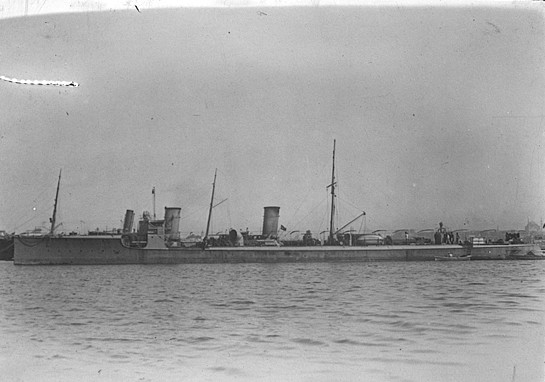
Destroyer TGC Muavenet, of German construction, like most of the fleet in 1914.
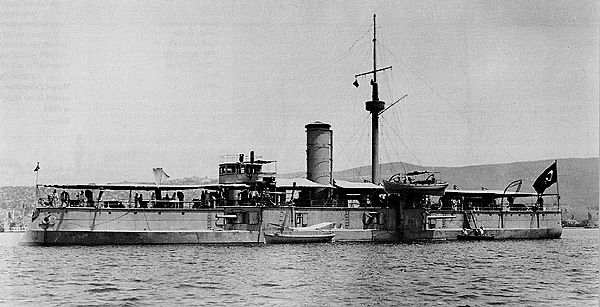
TGC Muin-I-Zaffer as rebuilt, seen here at Salonica in 1911
Detailed list of Turkish ships
Battleships:3 -H.Barbarossa class, Yavuz (1914)
Coastal BS:3 -Nijmi Sevket, Messudieh, Muin-I-Zaffer
Cruisers:3 -Hamidieh, Medjidieh, midilli (1914)
Destroyers:9 -Berk I Efsan, Yarhishar class, Muavenet class
Torpedo Gunboats:3 -Pelengri Deria, Berk I Savket class
Gunboats:19 -Sevket Numa class, Iz el Din, Zuhaf class, Marmaris, Yozgat, Sedd ul Bahr class, Isa Reis class, Preveze class
Armed Yachts:7 -Beirut, Galata, Cipka, Tarabulus, Istanbul, Ertugrul, Sogütlü
Minelayers:2 -Nusret, Intibah
Torpedo Gunboats:3 -Pelengri Deria, Berk I Savket class
Submersibles:2 -Müstecip Ombasi, 1 captured 1915
Torpedo Boats:32 -Abdul Mecid, Akhishar class, Hamidabad class, N°1-24 class
Links/sources
Ships list -Ottoman_steam_navy
Conway’s all the world fighting ships 1860-1905
en.wikipedia.org/wiki/World_War_I_naval_ships_of_the_Ottoman_Empire
Models corner
There’s not much here, apart from german models that can be used for three ships. If you have a good address please contact us !
NNT Modell – TGC Yavuz 1/700
Kombrig 1/700 Brandenburg
3d Model of the Messudieh (Turbosquid)
3d model of the Nusret on turbosquid
Turkish Ships of WW1
Battleships class Hayreddin Barbarossa (1891)

If the operations of the Turkish fleet were carried out with fast units, the battleships of the fleet were however anchored in Constantinople. Indeed for long the most recent Turkish battleship was the Messudieh, dating from 1875. In 1910, faced with impending war in the Balkans (and facing Greece), the Turkish government asked the kaiser for the purchase of two battleships then in reserve, from the Brandenburg class. After agreement on September 10, the two units, the Kurfürst Wilhelm and the Weissembourg were bought and joined Constantinople, while at the same time, the Turkish government approached the British for the construction of two other units. After their arrival, the two units were renamed Hayreddin Barbarossa and Torgud Reis, and repainted in khaki, the singular wartime livery of the Turkish Navy.
They were very active during the first Balkan War, bombing Varna, supporting the Chatajla line against the Bulgarians, then taking part in two naval battles against the Greeks on December 16, 1912 and January 18, 1913. Damaged, they each lost a casemate gun. They were also partially disarmed and their artillery ventilated between other auxiliary ships and fortifications of the Dardanelles. They served as coast guards in 1914-18. TGC Barbarossa was torpedoed and sunk by the E11 on August 8, 1915 near Boulair (Sea of Marmara). Torgud Reis, which towed the Yavuz seriously damaged by mines, saved it in January 1918. In 1928, she was converted into a training ship and broken up in 1957, after 66 years of good and loyal service.
specifications
Displacement: 10,500 t
Dimensions: 115.7 x 19.5 x 7.9 m
Propulsion: 2 shaft VTE steam engines, 12 boilers, 10,200 hp, 16.5 knots.
Armor: Main turrets 380 mm, belt 305 mm, barbettes 150 mm
Crew: 568.
Armament 6 x 280mm (3×2), 8 x 105mm, 8 x 88 mm, 6 TLT 450 mm.
T.C.G Yavuz Sultan Selim (1911)

The Yavuz Sultan Selim was not named that way until August 16, 1914. She was undoubtedly one the most famous ship of the war after the Lusitania in the consequences it engendered. Originally, the Kaiserflotte battle cruiser SMS Goeben (Moltke class) and her teamship, light cruiser SMS Breslau, formed the German Mediterranean squadron. With the outbreak of hostilities, Vice-Admiral Souchon managed to reach Constantinople during an epic chase (see the Goeben affair).
The Turkish fleet had recently been amputated from two vessels ordered and paid for at British shipyards, and diplomatic relations had stalled. The Kaiser saw there an opportunity to join the Ottoman Empire to his cause by opportunely offering the two German ships, put in a difficult position because of Turkish neutrality. On August 16, Souchon received the approval of the Kaiser and his officers combed the fez while Sultan Abdul Hamid II baptized the Goeben Yavuz Sultan Selim and the Breslau Midilli. Their first naval operation started on October 28, when Turkey declared war on Russia.
The two ex-German ships (with their original crew) were still under the command of Wilhelm Souchon, as grand admiral of the Turkish fleet. He carried out a series of bombardments of the Russian coast, in particular Odessa, Sevastopol, Novorrossisk. Then on November 18, the Yavuz carried out an interception of the Russian battleships of the Black Sea fleet. This became the battle of Cape Sarytch on November 18.
On December 10, she made another outing to Batum, but hit while returning on two Russian mines placed in the Bosphorus. Her repairs were completed in April, and the Yavuz made another sortie and met the Russian fleet. She left the duel with 2 large calibers hit on May 10. On January 20, 1918, she hit two other mines and was bombed twice by allied aviation. She carried out a total of 17 actions in the Black Sea, and was interned and inactive until 1926. From there, she was modernized b a French yard and served during the Second World War. She was written off and broken up in 1956, sadly the only example of a German battlecruiser of that era, and last battecruiser afloat.
specifications
Déplacement: 22 616 t, 25 300 t FL
Dimensions: 186,5 x 29,5 x 9 m
Propulsion: 4 shaft Parsons turbines, 24 Schultze-Thornycroft boilers= 52 000 hp. 25,5 knots
Armour: Battery 200, Citadel 200, Main turrets 230, belt 250, blockhaus 350, barbettes 230 mm
Equipage: 1355.
Armament: 10 x 280 (5×2), 12 x 150, 12 x 88, 4 x 500 mm TTs (Sub, fwd, aft, 2 bds)
Battleship Messudieh (1875)
The only battleship in the Turkish fleet before the first Balkan War in 1912 was a completely obsolete battleship, the only remaining from waves of old reformed mixed line ships dating back from the second half of the past century. She was rearmed in 1891 with three Krupp guns of 150 mm, then was completely rebuilt in 1898-1903 at the Ansaldo shipyards. She came out with a new superstructure, new machinery, and a new modern battery (See the sheet below). However the two 233 mm in turrets provided at the front and at aft were never assembled, and the Messudieh resumed service with… two wooden replicas instead !. Of questionable military value to say the least, she was sent to the Dardanelles Strait, firmly anchored in Charnak in addition to the coastal batteries. She was spotted and torpedoed by the British submersible B11 on December 1, 1914.
specifications
Displacement 9120 t standard
Dimensions 101 x 18 x 7.90 m
Propulsion 2 shaft TE steam engines, 16 Niclausse boilers, 11,000 hp, 16 knots.
Armor: Belt 305, battery 254, casemates 80, blockhouse 203, bridge 76 mm;
Crew 600
Armament 12 x 152, 14 x 76, 10 x 57, 2 x 47 mm guns.
Coastal armored ship Muin-I-Zaffer (1869)
Among the most ancient vessels of the Turkish fleet, the Muin-I-Zaffer was the survivor of a class of two small mixed casemate ironclads, with the Avni Illah lost in combat in 1912. These two mixed ex-ironclads of British construction were rearmed in 1891, while their mast were reduced, and they were completely rebuilt in Ansaldo in 1903-1907. They came out with a single military mast, a lighter hull, rebuilt with side casemates, but kept her original machinery but with new cylinder boilers, and armor. The two vessels participated in the Balkan War, and the Muin-I-Zaffer was still in service in 1914 as a coastal defense battery. She was put in reserve in 1916, her sailors being assigned to other ships, and she played no role during the rest of the war. It was broken up in 1922.
specifications
Displacement 2200 t standard
Dimensions 69 x 11 x 5 m
Propulsion 1 shaft, Horizontal Compound steam engine, 10 Niclausse boilers, 9000 hp, 13 knots.
Armor: Belt 152, casemates 102, CT 152, decks 76 mm
Crew 220.
Armament 4 x 150, 6 x 76, 10 x 57, 2 x 47 mm guns.
Cruiser Hamidieh (1903)
Second of the two modern cruisers of the Turkish fleet in 1914, the Hamidieh was commissioned under the name of Habdul Hamid in 1901 at Armstrong shipyards. It was practically identical to the Medjidieh, although appreciably heavier, longer and wider, with lower windsocks, it had the same protection, the same armament, except that the guns were manufactured by Vickers-Armstrong. Launched in September 1903 and completed in 1904, it was renamed Hamidieh in 1908.
She took part in the two Balkan wars, and on November 21, 1912, torpedoed in front of Varna. She returned to Constantinople at low speed, giving band, but was repaired and operated during the last days of the second Balkan war. She was very active however at the start of the great war against the Russians. She was refitted after the war with two Krupp 150 mm guns and eight 76 mm, then served as a training ship for fleet aspirants. In service during the Second World War, she was BU in 1947.
specifications
Displacement 3300 t standard
Dimensions 100.6 x 12.80 x 5.33 m
Propulsion 2 shaft 2 VTE steam engines, 12,500 hp, 22 knots
Armor: 102 mm deck crew, 30 mm bulkheads
Crew 312
Armament 2 x 152, 8 x 120, 6 x 75, 6 x 37, 2 x TT SM 457 mm broadside.
Cruiser Medjidieh (1903)

First of two modern cruisers in the Turkish fleet in 1914, the Medjidieh was ordered from Cramp shipyards in the USA at the same time as the Hamidieh at Vickers-Armstrong. It was practically identical to the latter, but nevertheless lighter, shorter and less wide, but also fast and benefiting from the same protection. He also had the same armament, except that the guns were manufactured by Bethlehem Steel. It stood out mainly for its more compact silhouette and high windsocks. She took part in the two Balkan wars, and was very active at the start of the great war against the Russians. It was during one of his sortie in April 3, 1915 that she hit a mine off Odessa. The Russians managed to captured her and repaired her, and she made a career until 1918 under the name of Prut, completely rebuilt in Nikolayev. She would return to Turkey in 1919 and served again, modernized in 1923 and active until 1947.
specifications
Displacement 3300 t standard
Dimensions 100.6 x 12.80 x 5.33 m
Propulsion 2 shaft 2 VTE engines, 12,500 hp, 22 knots max.
Armor 102 mm deck crew, 30 mm bulkheads; Crew 312
Armament 2 x 152, 8 x 120, 6 x 75, 6 x 37, 2 x sub TT 457 mm bds.
Cruiser T.C.G Midilli (1911)

This inseparable traveling companion of the SMS Goeben, light cruiser of the Magdeburg class by the name of SMS Breslau, became the Midilli on August 16, 1914, after having taken refuge in Constantinople. Already under the German flag, she had fired the first shots of the war by shelling Bône and Philippeville in Algeria on August 3, then crossed swords with HMS Goucester while heading east.
Under the Turkish flag, she was widely used in sorties with Yavuz, ex-Goeben, as a scout, but not hesitating to cross swords with other ships, like an old Russian battleship at the battle of Cape Sarytch in November 1914. The second of command was a young officer by the name of Karl Dönitz. On October 29, she devastated Novorrossisk, sinking 14 steamers and destroying the 40 oil tanks of the harbor, seriously hampering Russian moves in the areas. On December 23, she sank a transport and captured a cargo ship intended to block the port of Zonguldak.
In April 1915 she sank two other freighters, then the night of this action, helped by the powerful searchlights of the Yavuz, she sank three Russian destroyers. In August, a duel set her against other destroyers, and she sank two, after being badly hit. On July 4, TGC Midilli shelled Tuapse and Lazarevskoye, sinking the cargo ship Kniaz Obolensky. She was hit in the bow by the Russian Battleship Imperatrista Mariya. She laid mines in the Sea of Azov. In 1916, she replaced her 105 mm pieces with two 150 mm Krupp models, and in 1917, with a complete battery of 8 guns of this caliber. She was seriously damaged by a mine in July 1915, but definitively lost on January 20, 1918 by hitting 5 mines in a British field near Imbros, and sank by the stern in ten minutes with the two thirds of her crew. Yavuz survived her.
specifications
Displacement 4570 t – 5587 t Ft
Dimension 138.6 x 13.4 x 5.1 m
Propulsion 4 shafts, 2 turbines, 11 standard boilers, 35,500 hp. 28.2 knots
Armor (see Magdebug class)
Armament (1918) 12 x 150 mm, 2 x 500 mm TTs, 120 mines.
Nusret class minelayers (1912)

TGC Nusret (1912) and Intibah (1886), were high seas tugs converted into minelayers during wartime. They made both world wars and will be scrapped in 1957. TGC Nusret sank indirectly (by the minefield which she laid in the bay of Erin Keui at the entry of Dardanelles) three battleships, a French and two British. TGC Intibah had a very long career since she was completely rebuilt for laying mines and was also much larger than the Nusret at 616 tonnes. She was renamed Uyanik in 1942 and finally broken up in 1957. Finally, the Turkish navy also employed the TGC Kiresund, an old 3056 GRT civilian ship (1877) converted also as minelayer. She served during the Great War and was scrapped in 1927.
specifications (Nusret)
Displacement 364t FL
Dimensions 40.20 x 7.50 x 3.40 m
Propulsion 2 shaft triple 3 cyl. VE, 2 Schultz water-tube boilers, 1200ihp 12 knots
Armor None
Crew 149
Armament 2 × 37mm quick fire gun 60 mines
Yarishar class destroyers (1908)

Four destroyers were ordered in 1906 from the French shipyards of Gironde on the model of “Durandal” of 300 tons of Normand. The class included the Yarishar, Tasoz, Samsun, and Basra. They were delivered in 1908. They were very active during the two Balkan wars and the world conflict. The Yarishar was torpedoed on December 3, 1915 in the Gulf of Izmit, by the English submersible E11. The other three survived the conflict and were modernized in 1924. They were still used during the Second World War and were demolished in 1948.
specifications
Displacement 284 t standard
Dimensions 56 x 5.3 x 2.8 m
Propulsion 2 shaft VTE steam engines, 2 Normand boilers, 5950 hp= 28 knots.
Armor: none
Armament 1 x 65 mm, 6 x 47 mm, 2 x 450 mm TTs.
Muavenet class destroyers (1909)

Four destroyers were bought brand new in 1910 from the German Schichau shipyards of the “S165” type, transferred at the same time as the two battleships of the Barbarossa class. The class included Muavenet-I-Millet, Jadhigar-I-Millet, Numene-I-Hamije, and Gairet-I-Watanije. They were very active during the two Balkan wars and the world conflict. TGC Gairet ran aground on October 28, 1916 on a sandbank near Varna. The Turks scuttled him to avoid his capture. TGC Jadhigar for her part was bombed by RNAS aircraft in the golden horn and sunk on July 10, 1917. The other two were BU in 1920.
specifications
Displacement 665t, 765t PC
Dimensions 74.2 x 8 x 3 m
Propulsion 2 shaft Schichau turbines, 4 heaters, 17,500 hp 34 knots.
Armor: none
Crew 84
Armament 2 x 88 mm, 2 x 37 mm, 6 x 450 mm TTs.
Namet class Torpedo sloops (1890)
TGC Namet and the Pelengri Deria were built in Constantinople and launched in 1890, on British plans. Their armament was of Krupp origin. The first was disarmed in 1910 and the second rearmed in 1914. their original armament included two 104 mm guns, six 76 mm and three TTs including one in the bow. They were quite slow and made completely obsolete with the appearance of the destroyers. The first was on duty in Constantinople, at the point of Seraglio, and was torpedoed and sunk by the E11 which she had managed to cross the strait, on May 23, 1915.
specifications
Displacement 900 t standard
Dimensions 70 x 9.5 x 5 m
Propulsion 2 shaft horizontal TE, 2 loco boilers, 4500 hp= 19 knots max.
Crew 120
Armament 3 x 75 mm, 4 x 47 mm
Berk-I-Savket class Torpedo sloops (1906)
Although proceeding from a past fad concept, the Berk-I-Savket and the Peyk-I-Sevket were ordered by the Turkish admiralty from Germaniawerft shipyards in 1905. They were operational in 1907. They participated in the two Balkans wars, but without notable facts, then proceeded to the great war. The first was badly damaged by hitting a Russian mine on January 2, 1915 off the Bosphorus, but survived, was towed and repaired, to resume service in 1916.
The second was torpedoed on August 6, 1915 in the Sea of Marmara by an English submersible, and her commander succeeded in making it her sail on a sandbank. Towed, repaired, she also resumed service until 1918. After the war, these ships remained in service until 1937 before being completely rebuilt and refitted. They were not reformed until 1944.
specifications
Displacement 775t standard
Dimensions 80 x 8.4 x 2.5 m
Propulsion 2 shaft 2 VTE, 4 boilers, 5100 hp, 21 knots max.
Armor None
Crew 105.
Armament 2 x 105, 6 x 57, 4 x 37 mm (2 Revolver Hotchkiss), 3 x 450 mm TTs (1 in bow).
Isa Reis (1911-12)

Three units (Hizar Reis, Isa Reis and Duruk Reis) built in 1911-12, ordered from France (Forges & Shipyards of the Mediterranean) at the time of the Balkan War, and which were used as gunboats in 1914-18. All three jumped onto a Russian minefield in the Bosphorus, were bailed out, repaired and returned to service. In 1918, the Duruk Reis was renamed Kemal Reis. They were modernized in 1923 then were reconverted in 1938 into minesweepers. They operated until 1947-48.
specifications
Displacement 413 t standard
Dimensions 47 x 7.90 x 1.30 m
Propulsion 2 shaft VTE, 850 hp 14 knots
Crew 64
Armament 3 x 75, 2 x 47 Revolver Hotchkiss, 2 x 20 mm AA, 6 x 533 mm TTs.
Preveze (1912))
Four recent gunboats were ordered in 1910 from the Saint-Nazaire shipyards: These were the Preveze, Aydin Reis, Sakiz, and Burak Reis. They were launched between January and May 1912 and participated in the end of the second Balkan war. Operational in 1914, they were stationed in Constantinople. None were lost in action, but after the war, the Aydin Reis was donated by Mustafa Kemal’s government to the Russian government, as was the Preveze, to prevent them from being captured by the Allied Expeditionary Force.
The Russians surrendered them in 1922. Three were reformed in 1924, but the rearmed Aydin reis continued to serve until 1948. She was then used as a surveillance vessel and rearmed with 2 pieces of 76 mm and 2 of 57 mm, and fitted with new Babcock & Wilcox boilers.
specifications
Displacement 500t standard
Dimensions 54.3 x 8.5 x 2.4 m
Propulsion 2 shaft 2 VTE, 2 boilers, 1025 hp 14 knots max.
Crew 76.
Armament 2 guns of 100, 2 of 47 mm.

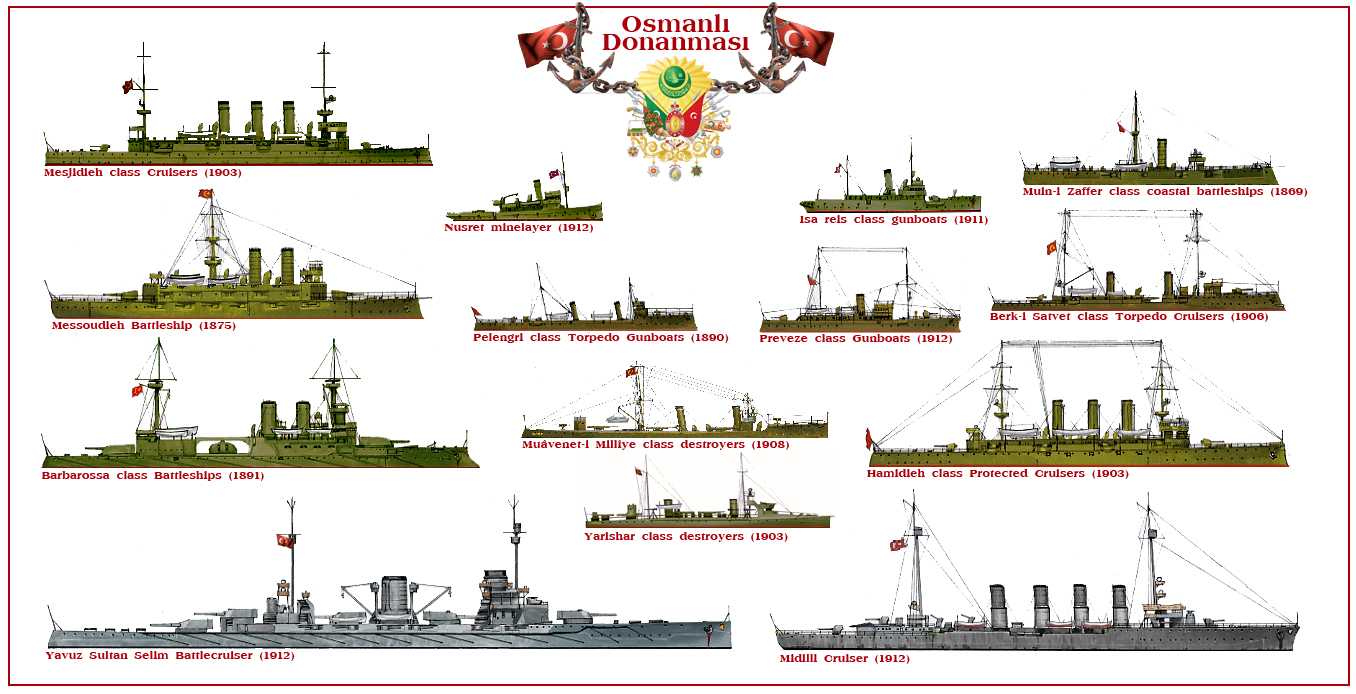

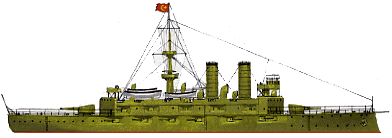
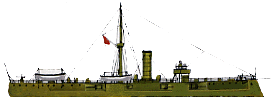


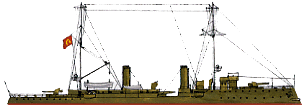

 Latest Facebook Entry -
Latest Facebook Entry -  X(Tweeter) Naval Encyclopedia's deck archive
X(Tweeter) Naval Encyclopedia's deck archive Instagram (@navalencyc)
Instagram (@navalencyc)





 French Navy
French Navy Royal Navy
Royal Navy Russian Navy
Russian Navy Armada Espanola
Armada Espanola Austrian Navy
Austrian Navy K.u.K. Kriegsmarine
K.u.K. Kriegsmarine Dansk Marine
Dansk Marine Nautiko Hellenon
Nautiko Hellenon Koninklije Marine 1870
Koninklije Marine 1870 Marinha do Brasil
Marinha do Brasil Osmanlı Donanması
Osmanlı Donanması Marina Do Peru
Marina Do Peru Marinha do Portugal
Marinha do Portugal Regia Marina 1870
Regia Marina 1870 Nihhon Kaigun 1870
Nihhon Kaigun 1870 Preußische Marine 1870
Preußische Marine 1870 Russkiy Flot 1870
Russkiy Flot 1870 Svenska marinen
Svenska marinen Søværnet
Søværnet Union Navy
Union Navy Confederate Navy
Confederate Navy Armada de Argentina
Armada de Argentina Imperial Chinese Navy
Imperial Chinese Navy Marinha do Portugal
Marinha do Portugal Mexico
Mexico Kaiserliche Marine
Kaiserliche Marine 1898 US Navy
1898 US Navy Sovietskiy Flot
Sovietskiy Flot Royal Canadian Navy
Royal Canadian Navy Royal Australian Navy
Royal Australian Navy RNZN Fleet
RNZN Fleet Chinese Navy 1937
Chinese Navy 1937 Kriegsmarine
Kriegsmarine Chilean Navy
Chilean Navy Danish Navy
Danish Navy Finnish Navy
Finnish Navy Hellenic Navy
Hellenic Navy Polish Navy
Polish Navy Romanian Navy
Romanian Navy Turkish Navy
Turkish Navy Royal Yugoslav Navy
Royal Yugoslav Navy Royal Thai Navy
Royal Thai Navy Minor Navies
Minor Navies Albania
Albania Austria
Austria Belgium
Belgium Columbia
Columbia Costa Rica
Costa Rica Cuba
Cuba Czechoslovakia
Czechoslovakia Dominican Republic
Dominican Republic Haiti
Haiti Hungary
Hungary Honduras
Honduras Estonia
Estonia Iceland
Iceland Eire
Eire Equador
Equador Iran
Iran Iraq
Iraq Latvia
Latvia Liberia
Liberia Lithuania
Lithuania Mandchukuo
Mandchukuo Morocco
Morocco Nicaragua
Nicaragua Persia
Persia San Salvador
San Salvador Sarawak
Sarawak Uruguay
Uruguay Venezuela
Venezuela Zanzibar
Zanzibar Warsaw Pact Navies
Warsaw Pact Navies Bulgaria
Bulgaria Hungary
Hungary

 Bundesmarine
Bundesmarine Dutch Navy
Dutch Navy Hellenic Navy
Hellenic Navy Marina Militare
Marina Militare Yugoslav Navy
Yugoslav Navy Chinese Navy
Chinese Navy Indian Navy
Indian Navy Indonesian Navy
Indonesian Navy JMSDF
JMSDF North Korean Navy
North Korean Navy Pakistani Navy
Pakistani Navy Philippines Navy
Philippines Navy ROKN
ROKN Rep. of Singapore Navy
Rep. of Singapore Navy Taiwanese Navy
Taiwanese Navy IDF Navy
IDF Navy Saudi Navy
Saudi Navy Royal New Zealand Navy
Royal New Zealand Navy Egyptian Navy
Egyptian Navy South African Navy
South African Navy






























 Ukrainian Navy
Ukrainian Navy dbodesign
dbodesign